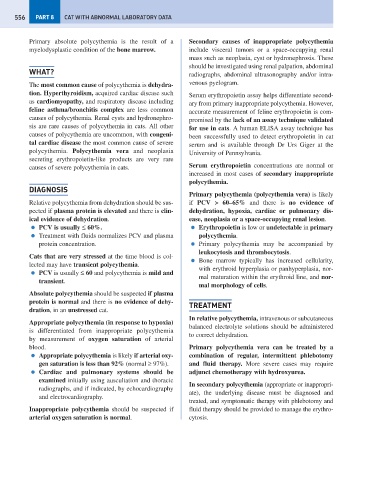Page 564 - Problem-Based Feline Medicine
P. 564
556 PART 8 CAT WITH ABNORMAL LABORATORY DATA
Primary absolute polycythemia is the result of a Secondary causes of inappropriate polycythemia
myelodysplastic condition of the bone marrow. include visceral tumors or a space-occupying renal
mass such as neoplasia, cyst or hydronephrosis. These
should be investigated using renal palpation, abdominal
WHAT? radiographs, abdominal ultrasonography and/or intra-
The most common cause of polycythemia is dehydra- venous pyelogram.
tion. Hyperthyroidism, acquired cardiac disease such Serum erythropoietin assay helps differentiate second-
as cardiomyopathy, and respiratory disease including ary from primary inappropriate polycythemia. However,
feline asthma/bronchitis complex are less common accurate measurement of feline erythropoietin is com-
causes of polycythemia. Renal cysts and hydronephro- promised by the lack of an assay technique validated
sis are rare causes of polycythemia in cats. All other for use in cats. A human ELISA assay technique has
causes of polycythemia are uncommon, with congeni- been successfully used to detect erythropoietin in cat
tal cardiac disease the most common cause of severe serum and is available through Dr Urs Giger at the
polycythemia. Polycythemia vera and neoplasia University of Pennsylvania.
secreting erythropoietin-like products are very rare
causes of severe polycythemia in cats. Serum erythropoietin concentrations are normal or
increased in most cases of secondary inappropriate
polycythemia.
DIAGNOSIS
Primary polycythemia (polycythemia vera) is likely
Relative polycythemia from dehydration should be sus- if PCV > 60–65% and there is no evidence of
pected if plasma protein is elevated and there is clin- dehydration, hypoxia, cardiac or pulmonary dis-
ical evidence of dehydration. ease, neoplasia or a space-occupying renal lesion.
● PCV is usually ≤ 60%. ● Erythropoietin is low or undetectable in primary
● Treatment with fluids normalizes PCV and plasma polycythemia.
protein concentration. ● Primary polycythemia may be accompanied by
leukocytosis and thrombocytosis.
Cats that are very stressed at the time blood is col-
● Bone marrow typically has increased cellularity,
lected may have transient polycythemia.
with erythroid hyperplasia or panhyperplasia, nor-
● PCV is usually ≤ 60 and polycythemia is mild and
mal maturation within the erythroid line, and nor-
transient.
mal morphology of cells.
Absolute polycythemia should be suspected if plasma
protein is normal and there is no evidence of dehy-
TREATMENT
dration, in an unstressed cat.
In relative polycythemia, intravenous or subcutaneous
Appropriate polycythemia (in response to hypoxia)
balanced electrolyte solutions should be administered
is differentiated from inappropriate polycythemia
to correct dehydration.
by measurement of oxygen saturation of arterial
blood. Primary polycythemia vera can be treated by a
● Appropriate polycythemia is likely if arterial oxy- combination of regular, intermittent phlebotomy
gen saturation is less than 92% (normal ≥ 97%). and fluid therapy. More severe cases may require
● Cardiac and pulmonary systems should be adjunct chemotherapy with hydroxyurea.
examined initially using auscultation and thoracic
In secondary polycythemia (appropriate or inappropri-
radiographs, and if indicated, by echocardiography
ate), the underlying disease must be diagnosed and
and electrocardiography.
treated, and symptomatic therapy with phlebotomy and
Inappropriate polycythemia should be suspected if fluid therapy should be provided to manage the erythro-
arterial oxygen saturation is normal. cytosis.

